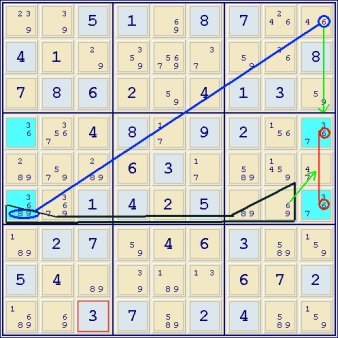Blind men should not post in forums. I have done this, and with the ancient spectacles I currently am wearing rather than ones that actually provide sight, I am farily certain that my post above is laden with errors. I have corrected the ones that I found. Hopefully some of the confusion is lessened.
One of the other deductions needs to be addressed:
- Code: Select all
*-----------------------------------------------------------------------------*
| 1 678 567 |*489 2 *789 | 5689 489 3 |
| 789 378 4 | 5 379 6 | 2 189 19 |
| 569 2 356 | 13489 349 1389 | 5689 7 4569 |
|-------------------------+-------------------------+-------------------------|
| 3 1467 12567 | 129 569 129 | 1679 1249 8 |
| 268 9 1268 | 7 36 4 | 136 5 126 |
| 24567 1467 12567 | 12389 3569 12389 | 13679 12349 124679 |
|-------------------------+-------------------------+-------------------------|
| 267 167 9 | 236 8 2357 | 4 23 1257 |
| 2478 5 12378 | 2349 3479 2379 | 1789 6 1279 |
| 24678 34678 23678 | 23469 1 23579 | 35789 2389 2579 |
*-----------------------------------------------------------------------------*
(9)r1c46 = (QNPx8)r1c46 - (8)r3c46 = (8)r3c7 - (8)r2c8 = (np19)r2c89 => r2c5, r1c78<>9
That, by itself, is horrible. One needs to actively reference the two sis, (47)c5, specifically, (4)r3c5 = (4-7)r8c5 = (7)r2c5. If both (4)r3c5, (7)r2c5 saw an ALS involving (47), one would have a continuous loop known as a Hub, Rim, Spoke configuration. However, they see an AALS at r1c46. This AALS is effectively now an ALS concerning candidates (89), therefor (9=8)r1c46 is justified.
To rewrite the chain, perhaps someone can suggest how they would write it. Here is another attempt:
(9)r1c46 = [(NT478)r1c46r23c5, since (4)r3c5 = (4-7)r8c5 = (7)r2c5] - (8)r3c46 = (8)r3c7 - (8)r2c8 = (np19)r2c89 => r2c5, r1c78<>9
Eleven, you present me with a real problem. When, once, I posted AIC's and deductions without referring to past patterns, I was criticized for not recognizing they were part of the deduction. Now, I am criticized for including them. Truly, it makes little difference to me which presentation is preferred.
Nevertheless, I will submit that recognizing that these atypical groupings of almost patterns we already know is helpful in finding potential links to them. Of course, it takes some practice to do so. To condemn the entire idea without really understanding it is contempt before investigation. I do recognize that the errors above have not helped the situation one bit.
Finally, I am notoriously obscure in my ramblings, and for that I apologize. I shall attempt to be more clear, and post when I can see what I write.


